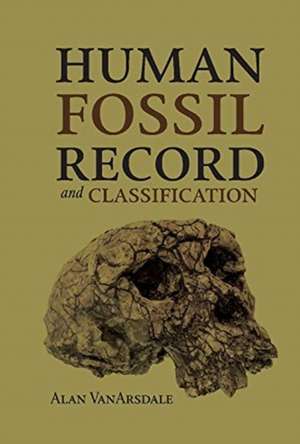Human Fossil Record and Classification
Autor Alan VanArsdaleen Limba Engleză Hardback – 26 iul 2020
Preț: 249.57 lei
Nou
Puncte Express: 374
Preț estimativ în valută:
47.77€ • 51.91$ • 40.15£
47.77€ • 51.91$ • 40.15£
Carte indisponibilă temporar
Doresc să fiu notificat când acest titlu va fi disponibil:
Se trimite...
Preluare comenzi: 021 569.72.76
Specificații
ISBN-13: 9781098304560
ISBN-10: 109830456X
Pagini: 136
Dimensiuni: 95 x 234 x 158 mm
Greutate: 0.36 kg
Editura: BOOKBABY
Colecția BookBaby
ISBN-10: 109830456X
Pagini: 136
Dimensiuni: 95 x 234 x 158 mm
Greutate: 0.36 kg
Editura: BOOKBABY
Colecția BookBaby
Notă biografică
About the Author Born Alan Darwin VanArsdale in 1961 in the Western United States. Has lived in Mexico China Ukraine and Honduras. Awarded AA at Oxnard City College and BS with one year of graduate studies from the College of Creative Studies at the University of California Santa Barbara in creative studies emphasis graduate level biology research in 2001. Previous publication includes the book "Roman Coin Forgery" 2005 a referenced work in forensic numismatics published in Bulgaria. Most recent employment numismatist and store owner at Ogden Utah last 15 years. The author has logged over 1000 days and nights camping in wilderness collecting terrestrial fossil mammals. Recovering more than 30,000 diagnostic fossil vertebrates. Mostly rodents but including many larger mammals such as elephants (Gomphotheres) fossils. With over 300 species and over 50 new species including a published new species of horse. Most fossils which are housed at the Los Angeles County Museum of Natural History, where the author was briefly employed including as a field party leader, the San Bernardino County Museum of Natural History and the Museum at the Texas A & M University. The author taught a paleontology course, adult education, for the Ventura County Parks and Recreation department including a field trip. The author was awarded a one-year stipend for field work before attending the University of California under the supervision of Dr Andre Wyss (vertebrate paleontologist), who was later one of the author's three academic advisors in graduate studies. At UCSB the author was awarded a university presidential fellowship to obtain absolute dates from field samples of volcanoclastic materials and led one UCSB anthropology field party studying lithic source materials of the Chumash tribe. At about the same time as the Alvarez team discovered diagenetically unaltered microtektites (which were previously unknown except in altered forms), the author discovered diagenetically unaltered microtektites in a terrestrial Miocene horizon in California, which were presented by Alessandro Montanari of the Alvarez team at a University of California Berkeley geophysics conference. The author made a high-resolution paleontological evaluation of the event horizon and determined there had been local rodent extinction (for an otherwise locally common mouse genus Copemys suggesting aridification) after the bolide impact event, with a one species fresh-water gastropod bloom just after the event (a coquina suggesting lack of predation). The author spent much of his childhood in the wilderness of NW Montana and spent the coldest part of the winter of 1981/1982 camping alone in remote mountains of NW Montana. Currently the author is planting and caring for his second remote organic fruit tree orchard, in a high elevation region in Idaho. Past formal studies by the author include vertebrate paleontology with emphasis on Neogene especially Miocene mammals, anthropology, mathematics as a major at Humboldt State University, sedimentary geology, macro-organismal genetics and stratigraphic archaeology. The author administrates the popular face book groups "The into Africa Theory" with the group founder Bruce Fenton who has written a popular book series "The Forgotten Exodus" on past human origins and migrations. And co-administrates the group Denisovan with the group founder, paleontologist Branislav Petkovic and a new administrator during the writing of this book Marc Young current graduate student in paleoanthropology.
